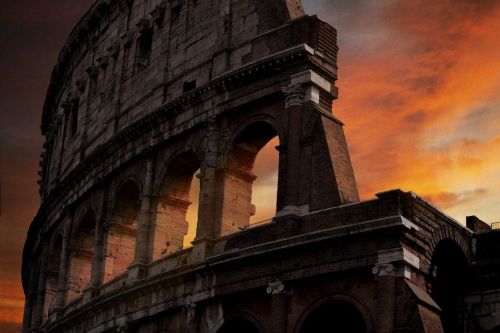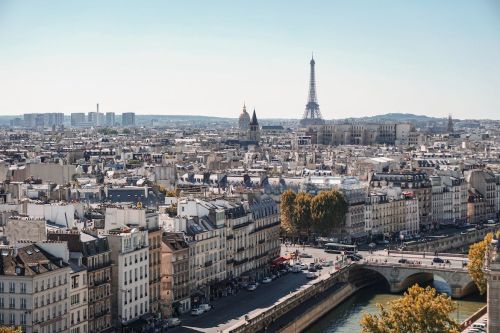The history of Rome has been continuous for 28 centuries, although it is known that the area was inhabited much earlier. Rome is one of the longest inhabited cities in the world. For centuries it was the capital of ancient Rome, which was first a kingdom, then a republic, and then an empire.
After the fall of the Roman Empire, the city slowly succumbed to the influence of the Catholic Church. The situation changed only when Rome was captured by Italian troops on September 20, 1870, and the Papal State ceased to exist.
Legend has it that Rome was founded by Romulus and his twin brother Remus. The boys were abandoned by their mother by the Tiber River. A female wolf found them and raised them as her children. When the brothers grew up, Romulus killed Remus and became the first ruler of Rome.
It was the center of civic and political life. Today the Forum is a tourist attraction where we can admire the architecture and art of the time.
In 2005, the city published a 59-point statute to protect animals. The law applies to both stray and domestic animals.
Although some are large and monumental, such as the Trevi Fountain, most of Rome's fountains are called nasone (fontanella) - small nose-shaped taps designed for drinking.
Even the ancient Romans called it that. They claimed that no matter what happened, their city would survive and continue to flourish.
Every night, about 3,000 euros are fished from the bottom of the Trevi Fountain. The money goes to the Caritas Foundation, which helps needy families in the Rome area.
Its construction was begun by Emperor Vespasian and completed by Titus Flavius. During the opening of the building, a 100-day festival began. Fierce fights with gladiators and wild animals took place in the arena of the Colosseum.
According to one Roman historian, about 9,000 wild animals were killed during the opening celebrations of the Colosseum.
Between 107 and 110 AD, Emperor Trajan built a shopping center called Mercato di Traiano. It had several levels and more than 150 shops selling everything from food to household goods to clothing.
Initially, togas were worn by both men and women. They were worn by all manual laborers. Over time, they became part of the Roman national identity. They served both ceremonial and social functions.
Togas were usually made of white wool. Around the 3rd century BC, women began to replace togas with stolas. These were long, pleated, sleeveless robes. They were worn by wealthy Roman women. The stola could be made of linen, wool and, for wealthy women, silk.
Unlike the toga, the stola had no predetermined color.
It is the most populous city in Italy and the third most populous in the European Union. The metropolitan area has a population of 4.34 million and is the eighth largest metropolitan area in the European Union.
90.5% of the city is made up of native Italians. The largest national minorities within the city are Bulgarians, Poles, Ukrainians, Albanians, Filipinos, Banglians and Chinese.

The most popular airport in Rome is Leonardo da Vinci Rome-Fiumicino.
Before the outbreak of the COVID-19 pandemic, it handled more than 43 million passengers per year. It is the eleventh busiest airport in Europe in terms of passenger traffic.
The Port of Civitavecchia is located on the outskirts of the metropolitan area, about 60 kilometers from the center of Rome. It has been known since ancient times, having been founded around 106 by Emperor Trajan. It is the main transport route between Italy and Sardinia.
It is located on the outskirts of Rome and covers an area of 40 hectares. Within this area there are as many as 22 shooting halls, production studios, sound studios, craft workshops and make-up rooms.
 Bernardo Bertolucci, Federico Fellini, Sergio Leone, Francis Ford Coppola, Martin Scorsese and Mel Gibson, among others, have worked at the studio. Agostino Zamboni / Flickr / CC BY-SA 2.0
Bernardo Bertolucci, Federico Fellini, Sergio Leone, Francis Ford Coppola, Martin Scorsese and Mel Gibson, among others, have worked at the studio. Agostino Zamboni / Flickr / CC BY-SA 2.0In the 1950s and 1960s, many internationally renowned filmmakers were attracted to Cinecittà. This period in the life of the studio was called "Hollywood on the Tiber".
S.P.Q.R. - the inscription we often see on Roman walls and monuments means "The Senate and People of Rome".
This abbreviation began appearing in Rome around 80 B.C. and was in use until the reign of Constantine the Great - the emperor who first adopted Christianity.
They dyed their hair blond and red with goat fat and beech ash.
Built between 106 and 113 A.D., it is covered with reliefs depicting 155 scenes with 2,662 figures, among which the emperor himself appears 58 times.
After its construction, a sculpture of an eagle was placed on the column, which was replaced by a statue of Trajan after the emperor's death. This statue towered over the area for almost a millennium and a half.
On December 4, 1587, a bronze statue of St. Peter the Apostle was placed on the column. This act was initiated by Pope Sixtus V. The statue adorns the column to this day.
It was harvested in specially designated areas and later used for tanning leather, cleaning various surfaces, or in medicine.
It was also used in industry, where it was used to treat wool before it found its way into the tailor's shop. The ammonia in urine was helpful in this case to remove grease from the wool fibers, as it has emulsifying properties.
The Romans believed that urine had medicinal properties. For example, it was used as a disinfectant for wounds and as a treatment for skin diseases. It was also used for sore throats and toothaches.
According to Tacitus, the conflagration lasted 5 1/2 days and destroyed 10 of the 14 districts of the city.
The Apostolic See has existed since January 17, 1377, when Pope Gregory XI moved it from the destroyed Lateran.
Formally, Vatican City has been an independent state only since February 24, 1929, when the Ecclesiastical State and the government of Bennito Mussolini signed a treaty formalizing its existence and functioning.
It was only after these events that it was decided to fortify the Basilica with walls. The fortification was ordered by Pope Leo IV, which is why the Basilica and its buildings were called the Leonine City.
 The graphic shows the appearance of the Leonine City around 1350, some 150 years before construction began on the new St. Peter's Basilica in Rome.Public domain
The graphic shows the appearance of the Leonine City around 1350, some 150 years before construction began on the new St. Peter's Basilica in Rome.Public domainIts origins are linked to the reign of Lucius Tarquinius Priscus, a period from 617 to 578 BC.
The Palatine is one of the seven hills of the city. From the time of Octavian Augustus, imperial palaces were built on this hill. Other important buildings were also placed here, and among them are:
Originally a municipal market, Piazza Navona began to be transformed into the representative square we know today during the pontificate of Innocent X between 1644 and 1655.
The first Olympic Games were scheduled to be held in Rome in 1908, but were canceled due to a volcanic eruption and moved to London.
AS Roma and S.S. Lazio provide an unforgettable experience for their fans. Lazio is the older club, founded in 1900; AS Roma was founded 27 years later. Both clubs play in Serie A, the highest football league in Italy.
There are 135 of them and they are one of the longest and widest stairway in Europe. Due to the large difference in height and the heavy traffic, the stairway has to be renovated frequently. The last such treatment took place in 2015 and lasted more than 11 months. The Spanish Steps were out of service during the repair work.
It is said that when the soldiers, tired of defending the city, fell asleep, they were awakened by the cries of these birds, which raised the alarm at the sight of the invaders approaching the buildings.

Construction began in 1506 on the site of an older church founded by Emperor Constantine the Great. It is the second largest church in the world, second in size only to the Basilica of Our Lady of Peace in Yamoussoukro, Ivory Coast.
St. Peter's Basilica measures 220 x 150 meters, is 136.6 meters high and its dome is 42 meters in diameter.












